The use of the word “cartel” nails it. As the months pass without a repeal and replacing of the hellish Obamacare, it’s becoming even more clear that the think tanks are losing the information war to an extent where they are not even reaching the relatively small band of members of congress that still have no clue.
Of all the issues that this website has covered well through so many links is that of health care reform. The materials are produced — they’re just not disseminated sufficiently by our side.
Here is Travis Klavohn writing at the Foundation for Economic Education:
In 2010, the small town of Collegedale, Tennessee had the dubious distinction of having the highest prevalence of Type II Diabetes in the world. Without a single endocrinologist in the small town, those suffering from this preventable and treatable form of the disease were unable to gain access to the treatment they needed.
Dealing with this issue firsthand, a local employer who operates a donut manufacturing plant decided to dedicate a portion of his warehouse to be used as a health clinic. By hiring an endocrinologist from Chattanooga to travel to his warehouse a few days a week, his employees were finally able to receive the help they so desperately needed.
The employer reasoned that the prices associated with the hiring of an endocrinologist were actually less costly for the company than the insurance expenses related to the disease.
The donut maker’s free market solution solved the problem of constrained supply of medical professionals for his employees. But this disconnect between supply and demand exists far beyond Collegedale. In fact, the country is experiencing a shortage of doctors in virtually all specialties and every state, which begs the question, where are all the doctors?
A Choreographed Shortage of Care
Though few Americans realize it, health care is a monopoly. In the early 20th century, the American Medical Association (AMA) lobbied the Federal government to close all schools not approved by its own Council on Medical Education. They unfortunately succeeded and 30 percent of medical schools were closed within 30 years. The number of doctors has been artificially capped ever since.
Read more: FEE.org
Image credit: Cartoon by A.F. Branco.

